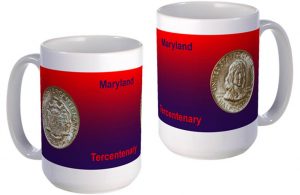 Today, the Maryland Tercentenary Commemorative Silver Half Dollar Coin remembers when Governor Leonard Calvert determined the settlement of St. Mary’s on March 27, 1634.
Today, the Maryland Tercentenary Commemorative Silver Half Dollar Coin remembers when Governor Leonard Calvert determined the settlement of St. Mary’s on March 27, 1634.
From The American Nation: A History, Volume 4; England in America, 1580-1652 by Lyon Gardiner Tyler, published in 1904:
=====
About the middle of October, 1633, Baltimore’s two ships got under way for America—the Ark, of three hundred tons, and the Dove, of sixty tons.
The emigrants consisted of twenty gentlemen and about three hundred laborers; and, while most of the latter were Protestants, the governor, Leonard Calvert, brother of Lord Baltimore, was a Catholic, as were Thomas Cornwallis and Gabriel Harvey, the two councillors associated with him in the government, and the other persons of influence on board.
Among the latter were two Jesuit priests, to one of whom, Father Andrew White, we owe a charming account of the voyage.
Baltimore, in his written instructions to his brother, manifested his policy of toleration, by directing him to allow no offence to be given to any Protestant on board, and to cause Roman Catholics to be silent “upon all occasions of discourse concerning matters of religion.”
The expedition did not get away from England without trouble. The attempt to divide the territory of Virginia was not popular, and Catholics were looked upon as dangerous persons.
The effort of the emigrants to sail without subscribing the necessary oaths caused the ships to be brought back by Admiral Pennington.
It was not until November 22, 1633, that they got off, and the ships took the old route to Virginia—by way of the West Indies.
February 27, 1634, they reached Point Comfort, where the king’s letter addressed to Sir John Harvey insured them a kind reception.
Here they learned that the Indians of the Potomac were excited over a rumor that they were Spaniards coming to subdue the country.
After a stay of eight or nine days for fresh provisions the emigrants set sail up Chesapeake Bay and soon entered the Potomac River, “in comparison with which the Thames seemed a rivulet.”
At its mouth they saw natives on shore in arms, and at night their watch-fires blazed throughout the country.
March 25 the settlers landed on St. Clement’s Island and erected a cross.
Then leaving the Ark with most of the passengers, Governor Calvert, with the Dove, and a pinnace bought at Point Comfort, explored the river and made friends with the Indians.
He found that they all acknowledged the sovereignty of the “emperor of Piscataqua,” who, relieved of his apprehensions, gave them permission to settle in the country.
The final choice of a seating-place was due to Captain Henry Fleet, a well-known member of the Virginia colony, who guided them up St. George’s River, about nine miles from its juncture with the Potomac; and there, on its north bank, March 27, 1634, Leonard Calvert laid out the city of St. Mary’s.
Though we have little record of the early social and economic conditions of the settlers, the colony appears to have been remarkably free from the sufferings and calamities that befell the Virginians.
This exemption was probably due to the following causes: there was no common stock, but the property was held in severalty; there was a proper proportion of gentlemen and laborers, few of one class and many of the other; Virginia was near at hand and provisions and cattle could be easily secured; and they had immediate use of Indian-cleared fields, because when they arrived at St. Mary’s, the Yaocomocos, harassed by the Susquehannas, were on the point of removing across the Potomac to Virginia, and were glad to sell what they had ceased to value.
It seems, too, that Maryland was healthier than Virginia.
Hence, the very first year they had an excellent crop of corn, and sent a ship-load to New England to exchange for salt fish and other provisions.
Imitating the example of the Virginians, they began immediately to plant tobacco, which, as in Virginia, became the currency and leading product. Its cultivation caused the importation of a great number of servants, “divers of very good rank and quality,” who, after a service of four or five years, became freemen.
In the assembly of 1638 several of the servants in the first emigration took their seats as burgesses. As the demand for houses and casks for tobacco was great, a good many carpenters and coopers came out at their own expense and received shares of land by way of encouragement.
A state of society developed similar in many respects to that in Virginia.
Baltimore, accustomed to the type of life in England, expected the settlements in Maryland to grow into towns and cities; and, under this impression, in January, 1638, he erected the population on the south side of St. George’s River into a “hundred,” and afterwards created other hundreds in other parts of the colony.
But the wealth of watercourses and the cultivation of tobacco caused the population to scatter, and made society from the first distinctly agricultural and rural.
St. Mary’s and St. George’s Hundred, in Maryland, shared the fate of Jamestown and Bermuda Hundred, in Virginia, and no stimulus of legislation could make them grow.
The application of the powers of the palatinate intensified these conditions by creating an agricultural and landed aristocracy.
=====
The Maryland Tercentenary Commemorative Silver Half Dollar Coin shows with an artist’s image, circa 1904, of Leonard Calvert.
